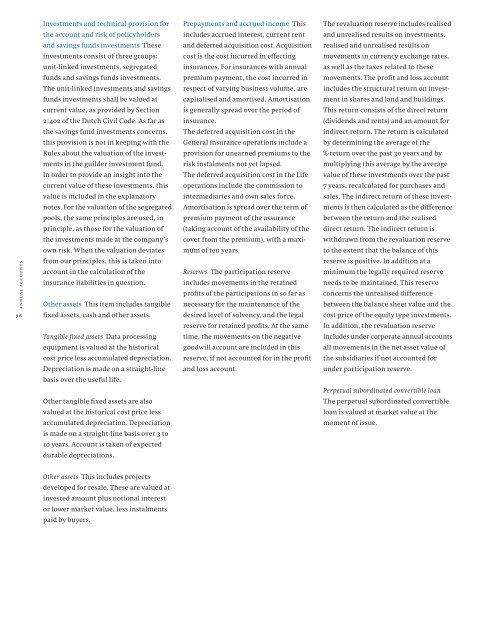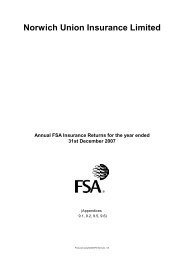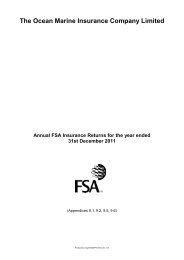PDF (1.82MB) - Aviva
PDF (1.82MB) - Aviva
PDF (1.82MB) - Aviva
You also want an ePaper? Increase the reach of your titles
YUMPU automatically turns print PDFs into web optimized ePapers that Google loves.
annual accounts<br />
76<br />
Investments and technical provision for<br />
the account and risk of policyholders<br />
and savings funds investments These<br />
investments consist of three groups:<br />
unit-linked investments, segregated<br />
funds and savings funds investments.<br />
The unit-linked investments and savings<br />
funds investments shall be valued at<br />
current value, as provided by Section<br />
2:402 of the Dutch Civil Code. As far as<br />
the savings fund investments concerns,<br />
this provision is not in keeping with the<br />
Rules about the valuation of the investments<br />
in the guilder investment fund.<br />
In order to provide an insight into the<br />
current value of these investments, this<br />
value is included in the explanatory<br />
notes. For the valuation of the segregated<br />
pools, the same principles are used, in<br />
principle, as those for the valuation of<br />
the investments made at the company’s<br />
own risk. When the valuation deviates<br />
from our principles, this is taken into<br />
account in the calculation of the<br />
insurance liabilities in question.<br />
Other assets This item includes tangible<br />
fixed assets, cash and other assets.<br />
Tangible fixed assets Data processing<br />
equipment is valued at the historical<br />
cost price less accumulated depreciation.<br />
Depreciation is made on a straight-line<br />
basis over the useful life.<br />
Other tangible fixed assets are also<br />
valued at the historical cost price less<br />
accumulated depreciation. Depreciation<br />
is made on a straight-line basis over 3 to<br />
10 years. Account is taken of expected<br />
durable depreciations.<br />
Other assets This includes projects<br />
developed for resale. These are valued at<br />
invested amount plus notional interest<br />
or lower market value, less instalments<br />
paid by buyers.<br />
Prepayments and accrued income This<br />
includes accrued interest, current rent<br />
and deferred acquisition cost. Acquisition<br />
cost is the cost incurred in effecting<br />
insurances. For insurances with annual<br />
premium payment, the cost incurred in<br />
respect of varying business volume, are<br />
capitalised and amortised. Amortisation<br />
is generally spread over the period of<br />
insurance.<br />
The deferred acquisition cost in the<br />
General insurance operations include a<br />
provision for unearned premiums to the<br />
risk instalments not yet lapsed.<br />
The deferred acquisition cost in the Life<br />
operations include the commission to<br />
intermediaries and own sales force.<br />
Amortisation is spread over the term of<br />
premium payment of the assurance<br />
(taking account of the availability of the<br />
cover from the premium), with a maximum<br />
of ten years.<br />
Reserves The participation reserve<br />
includes movements in the retained<br />
profits of the participations in so far as<br />
necessary for the maintenance of the<br />
desired level of solvency, and the legal<br />
reserve for retained profits. At the same<br />
time, the movements on the negative<br />
goodwill account are included in this<br />
reserve, if not accounted for in the profit<br />
and loss account.<br />
The revaluation reserve includes realised<br />
and unrealised results on investments,<br />
realised and unrealised results on<br />
movements in currency exchange rates,<br />
as well as the taxes related to these<br />
movements. The profit and loss account<br />
includes the structural return on investment<br />
in shares and land and buildings.<br />
This return consists of the direct return<br />
(dividends and rents) and an amount for<br />
indirect return. The return is calculated<br />
by determining the average of the<br />
%-return over the past 30 years and by<br />
multiplying this average by the average<br />
value of these investments over the past<br />
7 years, recalculated for purchases and<br />
sales. The indirect return of these investments<br />
is then calculated as the difference<br />
between the return and the realised<br />
direct return. The indirect return is<br />
withdrawn from the revaluation reserve<br />
to the extent that the balance of this<br />
reserve is positive. In addition at a<br />
minimum the legally required reserve<br />
needs to be maintained. This reserve<br />
concerns the unrealised difference<br />
between the balance sheet value and the<br />
cost price of the equity type investments.<br />
In addition, the revaluation reserve<br />
includes under corporate annual accounts<br />
all movements in the net asset value of<br />
the subsidiaries if not accounted for<br />
under participation reserve.<br />
Perpetual subordinated convertible loan<br />
The perpetual subordinated convertible<br />
loan is valued at market value at the<br />
moment of issue.






